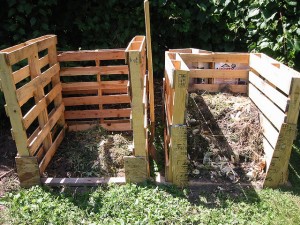Looking for an easy way to incorporate green living into your busy life? It doesn’t get much easier than composting: when organic wastes (like vegetable peels and coffee grounds) meet air and moisture, they’re going to break down into nitrogen-rich humus. The trick, of course, is harnessing this natural process in a manner that doesn’t create a smelly, ugly mess in the backyard (and make you the subject of discussion among the neighbors). Many opt to purchase a read-made bin at a local home store or online, but at $50-100 or more, this may seem like a lot to spend to dispose of kitchen scraps (even if you are getting garden fertilizer out of the deal).
Fortunately, you don’t have to buy those pre-made bins: with a little elbow grease and some easily-available materials, you can make your own. Don’t have a yard? No problem: methods like worm composting and bokashi work in small spaces, and also have DIY options available. Here are a few of the better projects out there for building your own compost bin.
1. The simple bin made from wooden pallets
Shipping pallets are one of the biggest sources of wood wastes, so making use of these freely available resources is green in and of itself. This project from The Lazy Homesteader requires just a few other items (which you may have laying around) to make a usable and presentable bin for composting. Make sure that the pallets you use haven’t been treated with preservatives or pesticides – you don’t want those in your compost!
2. The DIY Compost Tumbler
Tumblers make aerating and harvesting your compost even easier than a standard bin: just give it a few turns, and new wastes get separated from hummus that’s ready for your garden. This tumbler project from Instructables requires a bit more work than the pallet bin above, but should last for years when complete (and I don’t see why you couldn’t use a plastic barrel if you don’t have the tools for cutting metal).
3. The DIY Worm Bin
If space is tight for you, worm composting might be a better option for you. The idea of feeding your kitchen trash to worms, and harvesting their poop, might seem kind of gross, but it’s a pretty painless process that doesn’t smell (when done right – that’s always the caveat). This bin plan from the Washington State University extension service is cheap and easy to make (I’ve built one from this plan), and works great.
4. The DIY Bokashi Bucket
The Japanese practice of bokashi technically isn’t composting; rather, you’re fermenting those organic wastes. The upside of it, though, is that you can include many kinds of scraps that you can’t in more traditional composting: meat and dairy wastes work fine in a bokashi bucket. It’s also one of the easiest practices to start with readily-available materials: this following video walks you through the process of making your own bokashi bucket in less than a minute.
5. The DIY Black Soldier Fly Larvae Composting Bucket
Wait a minute: flies? Isn’t this supposed to be odor and mess-free? Black soldier flies aren’t your typical house flies, though: they don’t carry diseases, or even bite. They also get rid of those organic wastes much faster than traditional composting. This composter project from the Black Soldier Fly Blog is the most complex of those presented here; the trade-off, though, is that you’ll have plant food in weeks rather than months.
Know of other useful DIY plans for composters? Share them with us in the comments.
Jeff McIntire-Strasburg is the founder and editor of sustainablog.
